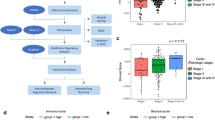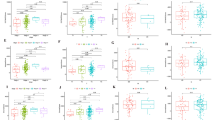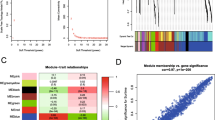Abstract
Purpose
Pancreatic adenocarcinoma (PAAD) is one of the most common causes of death among solid tumors, and its pathogenesis remains to be clarified. This study aims to elucidate the value of immune/stromal-related genes in the prognosis of PAAD through comprehensive bioinformatics analysis based on the immune microenvironment and validated in Chinese pancreatic cancer patients.
Methods
Gene expression profiles of pancreatic cancer patients were obtained from TCGA database. Differentially expressed genes (DEGs) were identified based on the ESTIMATE algorithm. Gene co-expression networks were constructed using WGCNA. In the key module, survival analysis was used to reveal the prognostic value. Subsequently, we performed functional enrichment analysis to construct a protein–protein interaction (PPI) network. The relationship between tumor immune infiltration and hub genes was analyzed by TIMER and CIBERSORT. Finally, it was validated in the GEO database and in tissues of Chinese pancreatic cancer patients.
Results
In the TCGA pancreatic cancer cohort, a low immune/stromal score was associated with a good prognosis. After bioinformatic analysis, 57 genes were identified to be significantly associated with pancreatic cancer prognosis. Among them, up-regulation of four genes (COL6A3, PLAU, MMP11 and MMP14) indicated poor prognosis and was associated with multiple immune cell infiltration. IHC results showed that PLAU protein levels from Chinese pancreatic cancer tissues were significantly higher than those from adjacent non-tumor tissues and were also associated with tumor TNM stage and lymph node metastasis.
Conclusion
In conclusion, this study demonstrates that PLAU may serve as a new diagnostic and therapeutic target, which is highly expressed in Chinese pancreatic cancer tissues and associated with lymph node metastasis.
Graphical abstract









Similar content being viewed by others
Data availability
Publicly available datasets were analyzed in this study. This data can be found here: https://portal.gdc.cancer.gov/ and https://www.ncbi.nlm.nih.gov/geo/.
References
Siegel RL, Miller KD, Fuchs HE, Jemal A (2021) Cancer statistics, 2021. CA Cancer J Clin. https://doi.org/10.3322/caac.21654
Mizrahi JD, Surana R, Valle JW, Shroff RT (2020) Pancreatic cancer. The Lancet 395:2008–2020. https://doi.org/10.1016/s0140-6736(20)30974-0
Carpenter ES, Steele NG, Pasca di Magliano M (2020) Targeting the microenvironment to overcome gemcitabine resistance in pancreatic cancer. Cancer Res 80:3070–3071. https://doi.org/10.1158/0008-5472.Can-20-1692
Sherman MH, Yu RT, Engle DD et al (2014) Vitamin D receptor-mediated stromal reprogramming suppresses pancreatitis and enhances pancreatic cancer therapy. Cell 159:80–93. https://doi.org/10.1016/j.cell.2014.08.007
Ware MB, El-Rayes BF, Lesinski GB (2020) Mirage or long-awaited oasis: reinvigorating T-cell responses in pancreatic cancer. J Immunother Cancer 8:e001100. https://doi.org/10.1136/jitc-2020-001100
Ren B, Cui M, Yang G, Wang H, Feng M, You L, Zhao Y (2018) Tumor microenvironment participates in metastasis of pancreatic cancer. Mol Cancer 17:108. https://doi.org/10.1186/s12943-018-0858-1
Feig C, Gopinathan A, Neesse A, Chan DS, Cook N, Tuveson DA (2012) The pancreas cancer microenvironment. Clin Cancer Res 18:4266–4276. https://doi.org/10.1158/1078-0432.CCR-11-3114
Zhang H, Li M, Kaboli PJ et al (2021) Identification of cluster of differentiation molecule-associated microRNAs as potential therapeutic targets for gastrointestinal cancer immunotherapy. Int J Biol Markers 36:22–32. https://doi.org/10.1177/17246008211005473
Zhao Q, Jiang Y, **ang S et al (2021) Engineered TCR-T Cell Immunotherapy in anticancer precision medicine: pros and cons. Front Immunol 12:658753. https://doi.org/10.3389/fimmu.2021.658753
Looi CK, Chung FF, Leong CO, Wong SF, Rosli R, Mai CW (2019) Therapeutic challenges and current immunomodulatory strategies in targeting the immunosuppressive pancreatic tumor microenvironment. J Exp Clin Cancer Res 38:162. https://doi.org/10.1186/s13046-019-1153-8
Leinwand J, Miller G (2020) Regulation and modulation of antitumor immunity in pancreatic cancer. Nat Immunol 21:1152–1159. https://doi.org/10.1038/s41590-020-0761-y
Yoshihara K, Shahmoradgoli M, Martinez E et al (2013) Inferring tumour purity and stromal and immune cell admixture from expression data. Nat Commun 4:2612. https://doi.org/10.1038/ncomms3612
Yan H, Qu J, Cao W, Liu Y, Zheng G, Zhang E, Cai Z (2019) Identification of prognostic genes in the acute myeloid leukemia immune microenvironment based on TCGA data analysis. Cancer Immunol Immunother CII 68:1971–1978. https://doi.org/10.1007/s00262-019-02408-7
Zhou L, Huang W, Yu H, Feng Y, Teng X (2020) Exploring TCGA database for identification of potential prognostic genes in stomach adenocarcinoma. Cancer Cell Int 20:264. https://doi.org/10.1186/s12935-020-01351-3
**ang S, Li J, Shen J et al (2021) Identification of Prognostic Genes in the Tumor Microenvironment of Hepatocellular Carcinoma. Front Immunol 12:653836. https://doi.org/10.3389/fimmu.2021.653836
Szklarczyk D, Franceschini A, Wyder S et al (2015) STRING v10: protein-protein interaction networks, integrated over the tree of life. Nucl Acids Res 43:D447–D452. https://doi.org/10.1093/nar/gku1003
Shannon P, Markiel A, Ozier O, Baliga N, Wang J, Ramage D, Amin N, Schwikowski B, Ideker T (2003) Cytoscape: a software environment for integrated models of biomolecular interaction networks. Genome Res 13:2498–2504. https://doi.org/10.1101/gr.1239303
Newman AM, Liu CL, Green MR, Gentles AJ, Feng W, Xu Y, Hoang CD, Diehn M, Alizadeh AA (2015) Robust enumeration of cell subsets from tissue expression profiles. Nat Methods 12:453–457. https://doi.org/10.1038/nmeth.3337
Brahmer JR, Tykodi SS, Chow LQ et al (2012) Safety and activity of anti-PD-L1 antibody in patients with advanced cancer. N Engl J Med 366:2455–2465. https://doi.org/10.1056/NEJMoa1200694
Hegde S, Krisnawan VE, Herzog BH et al (2020) Dendritic cell paucity leads to dysfunctional immune surveillance in pancreatic cancer. Cancer Cell 37:289–307. https://doi.org/10.1016/j.ccell.2020.02.008
Honselmann KC, Finetti P, Birnbaum DJ et al (2020) Neoplastic-stromal cell crosstalk regulates matrisome expression in pancreatic cancer. Mol Cancer Res 18:1889–1902. https://doi.org/10.1158/1541-7786.MCR-20-0439
Incio J, Liu H, Suboj P et al (2016) Obesity-induced inflammation and desmoplasia promote pancreatic cancer progression and resistance to chemotherapy. Cancer Discov 6:852–869. https://doi.org/10.1158/2159-8290.CD-15-1177
Neesse A, Frese KK, Bapiro TE et al (2013) CTGF antagonism with mAb FG-3019 enhances chemotherapy response without increasing drug delivery in murine ductal pancreas cancer. Proc Natl Acad Sci U S A 110:12325–12330. https://doi.org/10.1073/pnas.1300415110
Hwang RF, Moore T, Arumugam T, Ramachandran V, Amos KD, Rivera A, Ji B, Evans DB, Logsdon CD (2008) Cancer-associated stromal fibroblasts promote pancreatic tumor progression. Cancer Res 68:918–926. https://doi.org/10.1158/0008-5472.CAN-07-5714
Cheng H, Fan K, Luo G et al (2019) Kras mutation contributes to regulatory T cell conversion through activation of the MEK/ERK pathway in pancreatic cancer. Cancer Lett 446:103–111. https://doi.org/10.1016/j.canlet.2019.01.013
Trovato R, Fiore A, Sartori S et al (2019) Immunosuppression by monocytic myeloid-derived suppressor cells in patients with pancreatic ductal carcinoma is orchestrated by STAT3. J Immunother Cancer 7:255. https://doi.org/10.1186/s40425-019-0734-6
Barilla R, Diskin B, Caso R et al (2019) Specialized dendritic cells induce tumor-promoting IL-10IL-17 FoxP3 regulatory CD4 T cells in pancreatic carcinoma. Nat Commun 10:1424. https://doi.org/10.1038/s41467-019-09416-2
Fan K, Yang C, Fan Z et al (2018) MUC16 C terminal-induced secretion of tumor-derived IL-6 contributes to tumor-associated Treg enrichment in pancreatic cancer. Cancer Lett 418:167–175. https://doi.org/10.1016/j.canlet.2018.01.017
Rucki A, Foley K, Zhang P et al (2017) Heterogeneous stromal signaling within the tumor microenvironment controls the metastasis of pancreatic cancer. Cancer Res 77:41–52. https://doi.org/10.1158/0008-5472.Can-16-1383
Heeg S, Das KK, Reichert M et al (2016) ETS-transcription factor ETV1 regulates stromal expansion and metastasis in pancreatic cancer. Gastroenterology 151(540–53):e14. https://doi.org/10.1053/j.gastro.2016.06.005
Krishnamoorthy M, Lenehan J, Burton J, Maleki Vareki S (2020) Immunomodulation in pancreatic cancer. Cancers (Basel) 12:3340. https://doi.org/10.3390/cancers12113340
Shi H, Fang W, Liu M, Fu D (2017) Complement component 1, q subcomponent binding protein (C1QBP) in lipid rafts mediates hepatic metastasis of pancreatic cancer by regulating IGF-1/IGF-1R signaling. Int J Cancer 141:1389–1401. https://doi.org/10.1002/ijc.30831
Bulle A, Lim K (2020) Beyond just a tight fortress: contribution of stroma to epithelial-mesenchymal transition in pancreatic cancer. Signal Transduct Target Ther 5:249. https://doi.org/10.1038/s41392-020-00341-1
Sakamoto H, Attiyeh M, Gerold J et al (2020) The evolutionary origins of recurrent pancreatic cancer. Cancer Discov 10:792–805. https://doi.org/10.1158/2159-8290.Cd-19-1508
Han X, Zhang W, Wang W, Yu X, Liu L (2020) Cancer-associated fibroblasts in therapeutic resistance of pancreatic cancer: present situation, predicaments, and perspectives. Biochimica et biophysica acta. Rev Cancer 1874:188444. https://doi.org/10.1016/j.bbcan.2020.188444
Yu M, Tannock I (2012) Targeting tumor architecture to favor drug penetration: a new weapon to combat chemoresistance in pancreatic cancer? Cancer Cell 21:327–329. https://doi.org/10.1016/j.ccr.2012.03.002
Tan X, Sivakumar S, Bednarsch J et al (2020) Nerve fibers in the tumor microenvironment in neurotropic cancer-pancreatic cancer and cholangiocarcinoma. Oncogene 40:899–908. https://doi.org/10.1038/s41388-020-01578-4
Zahalka A, Frenette P (2020) Nerves in cancer. Nat Rev Cancer 20:143–157. https://doi.org/10.1038/s41568-019-0237-2
Preston M, Sherman L (2011) Neural stem cell niches: roles for the hyaluronan-based extracellular matrix. Front Biosci (Schol Ed) 3:1165–1179. https://doi.org/10.2741/218
Gritsenko P, Ilina O, Friedl P (2012) Interstitial guidance of cancer invasion. J Pathol 226:185–199. https://doi.org/10.1002/path.3031
Zhang X, Huang S, Guo J, Zhou L, You L, Zhang T, Zhao Y (2016) Insights into the distinct roles of MMP-11 in tumor biology and future therapeutics (Review). Int J Oncol 48:1783–1793. https://doi.org/10.3892/ijo.2016.3400
Jones L, Humphreys M, Campbell F, Neoptolemos J, Boyd M (2004) Comprehensive analysis of matrix metalloproteinase and tissue inhibitor expression in pancreatic cancer: increased expression of matrix metalloproteinase-7 predicts poor survival. Clin Cancer Res An Off J Am Assoc Cancer Res 10:2832–2845. https://doi.org/10.1158/1078-0432.ccr-1157-03
Zhang X, Lu J, Zhou L, You L, Liang Z, Guo J, Zhao Y (2020) Matrix metalloproteinase 11 as a novel tumor promoter and diagnostic and prognostic biomarker for pancreatic ductal adenocarcinoma. Pancreas 49:812–821. https://doi.org/10.1097/mpa.0000000000001583
Haage A, Nam D, Ge X, Schneider I (2014) Matrix metalloproteinase-14 is a mechanically regulated activator of secreted MMPs and invasion. Biochem Biophys Res Commun 450:213–218. https://doi.org/10.1016/j.bbrc.2014.05.086
Arafat H, Lazar M, Salem K, Chipitsyna G, Gong Q, Pan T, Zhang R, Yeo C, Chu M (2011) Tumor-specific expression and alternative splicing of the COL6A3 gene in pancreatic cancer. Surgery 150:306–315. https://doi.org/10.1016/j.surg.2011.05.011
Lamandé S, Bateman J (2018) Collagen VI disorders: insights on form and function in the extracellular matrix and beyond. Matrix Biol 71–72:348–367. https://doi.org/10.1016/j.matbio.2017.12.008
Svoronos C, Tsoulfas G, Souvatzi M, Chatzitheoklitos E (2020) Prognostic value of COL6A3 in pancreatic adenocarcinoma. Ann Hepatobiliary Pancreat Surg 24:52–56
Sherman-Baust C, Weeraratna A, Rangel L, Pizer E, Cho K, Schwartz D, Shock T, Morin P (2003) Remodeling of the extracellular matrix through overexpression of collagen VI contributes to cisplatin resistance in ovarian cancer cells. Cancer Cell 3:377–386. https://doi.org/10.1016/s1535-6108(03)00058-8
Park J, Morley T, Scherer P (2013) Inhibition of endotrophin, a cleavage product of collagen VI, confers cisplatin sensitivity to tumours. EMBO Mol Med 5:935–948. https://doi.org/10.1002/emmm.201202006
Banys-Paluchowski M, Witzel I, Aktas B et al (2019) The prognostic relevance of urokinase-type plasminogen activator (uPA) in the blood of patients with metastatic breast cancer. Sci Rep 9:2318. https://doi.org/10.1038/s41598-018-37259-2
Ai C, Zhang J, Lian S, Ma J, Győrffy B, Qian Z, Han Y, Feng Q (2020) FOXM1 functions collaboratively with PLAU to promote gastric cancer progression. J Cancer 11:788–794. https://doi.org/10.7150/jca.37323
Moquet-Torcy G, Tolza C, Piechaczyk M, Jariel-Encontre I (2014) Transcriptional complexity and roles of Fra-1/AP-1 at the uPA/Plau locus in aggressive breast cancer. Nucl Acids Res 42:11011–11024. https://doi.org/10.1093/nar/gku814
Dikshit B, Irshad K, Madan E et al (2013) FAT1 acts as an upstream regulator of oncogenic and inflammatory pathways, via PDCD4, in glioma cells. Oncogene 32:3798–3808. https://doi.org/10.1038/onc.2012.393
Li X, Rawat K, Jakubzick CV (2021) Targeting resident macrophages in cancer. Nat Immunol 22:1078–1079. https://doi.org/10.1038/s41590-021-01002-3
Cui D, Yuan W, Chen C, Han R (2021) Identification of colorectal cancer-associated macrophage biomarkers by integrated bioinformatic analysis. Int J Clin Exp Pathol 14:1–8
Fang L, Che Y, Zhang C, Huang J, Lei Y, Lu Z, Sun N, He J (2021) PLAU directs conversion of fibroblasts to inflammatory cancer-associated fibroblasts, promoting esophageal squamous cell carcinoma progression via uPAR/Akt/NF-κB/IL8 pathway. Cell Death Discov 7:32. https://doi.org/10.1038/s41420-021-00410-6
He F, Chen H, Probst-Kepper M, Geffers R, Eifes S, Del Sol A, Schughart K, Zeng A-P, Balling R (2012) PLAU inferred from a correlation network is critical for suppressor function of regulatory T cells. Mol Syst Biol 8:624. https://doi.org/10.1038/msb.2012.56
Acknowledgements
This work was supported by the National Natural Science Foundation of China (grants 81570537 and 81974074 to Y.C).
Author information
Authors and Affiliations
Contributions
HW and YC contributed to conceptualization; LL and HW provided methodology; LL and HW performed formal analysis and writing. HW and XL performed writing—review and editing; YC contributed to funding acquisition. All authors have read and agreed to the published version of the manuscript.
Corresponding author
Ethics declarations
Conflict of Interest
The authors declare no conflict of interest.
Ethical standards
All datasets are freely available as public resources. Therefore, local ethics approval was not needed.
Additional information
Publisher's Note
Springer Nature remains neutral with regard to jurisdictional claims in published maps and institutional affiliations.
Supplementary Information
Below is the link to the electronic supplementary material.
Rights and permissions
About this article
Cite this article
Wang, H., Lu, L., Liang, X. et al. Identification of prognostic genes in the pancreatic adenocarcinoma immune microenvironment by integrated bioinformatics analysis. Cancer Immunol Immunother 71, 1757–1769 (2022). https://doi.org/10.1007/s00262-021-03110-3
Received:
Accepted:
Published:
Issue Date:
DOI: https://doi.org/10.1007/s00262-021-03110-3




